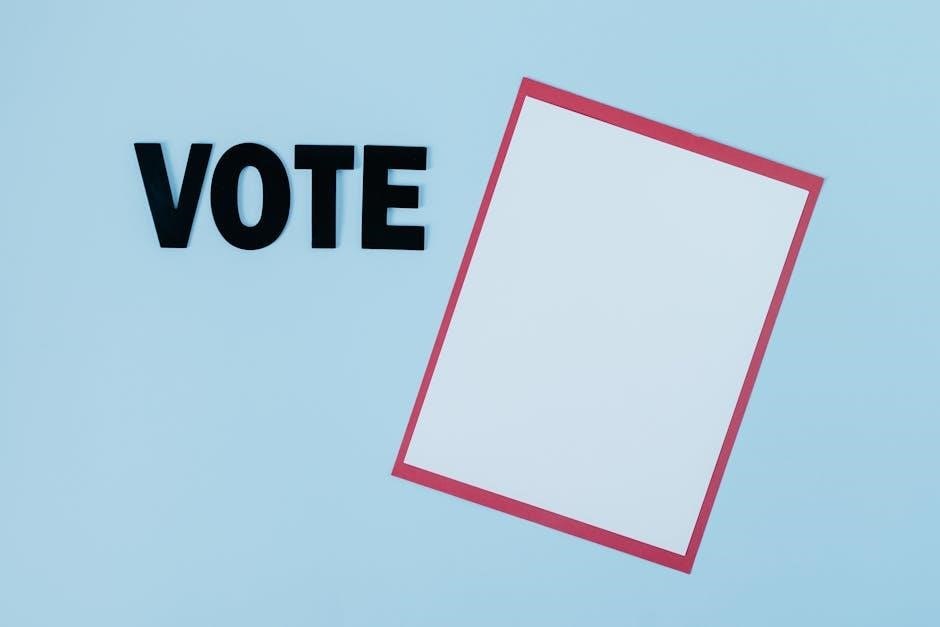Foundations of American Government
Federalism and the separation of powers form the cornerstone of American governance, ensuring balanced authority between national and state levels, influenced by landmark cases like McCulloch v․ Maryland․
Key Concepts and Principles
The foundational principles of American government include federalism, separation of powers, and checks and balances․ Federalism divides authority between the federal and state governments, ensuring shared sovereignty․ The separation of powers distributes power among the legislative, executive, and judicial branches to prevent abuse․ Checks and balances further ensure accountability by allowing each branch to limit the actions of the others․ Additionally, the concept of individual rights, as outlined in the Declaration of Independence and the Constitution, underscores the protection of life, liberty, and the pursuit of happiness․ These principles collectively establish a framework for a democratic system designed to safeguard freedoms and promote justice․
The Three Branches of Government
The U․S․ government is structured into three branches: legislative, executive, and judicial․ The legislative branch, composed of Congress (House and Senate), creates laws․ The executive branch, led by the President, enforces laws․ The judicial branch, headed by the Supreme Court, interprets laws․ This division ensures power is distributed evenly, preventing any single branch from dominating․ Each branch has distinct roles and responsibilities, with checks and balances to maintain accountability․ Understanding these branches is crucial for grasping how the federal government operates and maintains its democratic structure․ This system is fundamental to American governance, ensuring no branch oversteps its authority while working together to uphold the Constitution and serve the public interest effectively․
Federalism and Its Importance
Federalism is a cornerstone of the U․S․ government, dividing power between the federal government and the states․ This system ensures that authority is shared, preventing centralized control․ The federal government handles matters like national defense and foreign policy, while states manage local issues such as education and transportation․ Federalism promotes state autonomy and adaptability, allowing states to address unique regional needs․ Landmark cases, like McCulloch v․ Maryland, have upheld federal authority over state challenges, reinforcing the balance of power․ Federalism fosters innovation and accountability at both levels, ensuring a dynamic and responsive governance structure․ It remains vital for maintaining unity while respecting diversity across the nation․

The Constitution
The Constitution is the foundation of the U․S․ government, establishing its framework, principles, and amendments․ It ensures rights, separation of powers, and adaptability through amendments, guiding governance and justice․
The Ratification Process

The ratification of the U․S․ Constitution was a pivotal moment in American history, requiring approval from nine states․ Federalists, who supported the Constitution, faced opposition from Anti-Federalists, who feared a strong central government․ Key debates centered on individual rights and state sovereignty․ The Federalists, including influential figures like James Madison, argued that the Constitution balanced power and protected liberties․ To address concerns, Madison promised to add a Bill of Rights, which later became the first ten amendments․ The process began in 1787 and concluded in 1788, with Virginia and New York being crucial for ratification․ The final approval came on June 21, 1788, when New Hampshire became the ninth state to ratify, ensuring the Constitution’s adoption and shaping the nation’s future governance․
The Bill of Rights
The Bill of Rights, comprising the first ten amendments to the U․S․ Constitution, ensures fundamental liberties and protections for citizens․ Adopted in 1791, it addresses freedoms such as speech, religion, and the right to bear arms․ The Fourth Amendment safeguards against unreasonable searches and seizures, while the Fifth guarantees due process and protects against self-incrimination․ The Bill of Rights limits government overreach, reflecting the Founders’ commitment to individual liberties․ It has been interpreted and expanded over time, with the 14th Amendment’s selective incorporation applying many of these rights to state levels․ These amendments remain central to American law and identity, protecting citizens’ rights and shaping legal precedents․
Amendments and Their Significance
Amendments to the U․S․ Constitution are crucial for adapting the document to societal changes and legal needs․ The process, outlined in Article V, requires a two-thirds majority in both congressional chambers or a national convention called by two-thirds of state legislatures․ The 13th Amendment abolished slavery, while the 19th granted women the right to vote, exemplifying their transformative impact․ The 26th Amendment lowered the voting age to 18, ensuring younger citizens’ voices are heard․ These changes reflect evolving notions of equality and justice․ Amendments also address structural concerns, such as presidential succession and congressional pay․ Their significance lies in their ability to refine governance and expand rights, ensuring the Constitution remains a living document responsive to the nation’s growth and values․

The Legislative Branch
The Legislative Branch, composed of Congress, includes the House of Representatives and the Senate․ It holds the power to make laws, approve appointments, and control federal spending․
Structure and Function
The Legislative Branch, composed of Congress, is divided into the House of Representatives and the Senate․ The House has 435 members, each representing a district based on population, while the Senate has 100 members, with two senators per state․ Congress’s primary function is to make laws, approve presidential appointments, and control federal spending․ It also conducts oversight of executive actions and holds the power of impeachment․ The bicameral system ensures balanced representation, with the House focusing on population-based issues and the Senate providing equal state representation․ This structure enables Congress to fulfill its constitutional role in governance, ensuring accountability and checks and balances within the federal system․
Powers and Responsibilities
The Legislative Branch holds significant powers, including lawmaking, budget approval, and impeachment․ Congress can levy taxes, declare war, and regulate commerce, while also overseeing executive actions․ Its responsibility includes representing constituent interests, conducting hearings, and approving presidential appointments․ The House initiates revenue bills, while the Senate provides advice and consent on treaties and nominations․ Congress ensures accountability through investigations and subpoenas, maintaining checks on the other branches․ These powers and responsibilities are essential for upholding constitutional governance, ensuring public interests are represented, and maintaining the balance of power within the federal system․ Effective legislation and oversight are critical to addressing national issues and safeguarding democratic principles․
The Lawmaking Process
The lawmaking process in the U․S․ is a multi-step system designed to ensure careful consideration and collaboration․ A bill is first introduced in either the House or Senate, often inspired by public opinion or executive suggestions․ It is then reviewed by committees, where amendments may be proposed․ After committee approval, the bill is debated on the chamber floor, with members voting on its passage․ If approved, it moves to the other chamber for similar review․ Differences are resolved in conference committees․ Once agreed upon, the bill is sent to the President, who can sign it into law or veto it․ Congress can override a veto with a two-thirds majority in both chambers․ This process ensures accountability and representation, reflecting democratic principles․
The Executive Branch
The Executive Branch, led by the President, executes laws and oversees federal administration․ The Cabinet and executive departments assist in policy implementation and national security matters․
The Role of the President
The President serves as both the head of state and government, executing laws and overseeing federal administration; As Commander-in-Chief, the President leads the armed forces and conducts foreign policy․ The role includes vetoing legislation, negotiating treaties, and appointing federal judges and Cabinet members․ The President also addresses Congress annually on the state of the union․ Key powers include granting pardons and reprieves, except in impeachment cases․ The 3rd Amendment, ensuring no soldier shall quarter in homes without consent, reflects early concerns about executive overreach․ The President’s leadership is balanced by checks and balances within the constitutional framework, ensuring accountability while upholding national security and unity․
Powers of the Executive Branch
The Executive Branch, led by the President, holds significant powers to enforce federal laws, command the military, and conduct foreign policy․ The President can veto legislation, though Congress may override it with a two-thirds majority․ Executive agreements and treaties shape international relations, while the President appoints federal judges, ambassadors, and Cabinet members․ The Cabinet, comprising heads of executive departments, assists in policy implementation․ Key cases like McCulloch v․ Maryland have expanded federal authority, reinforcing the Executive Branch’s role in regulating interstate commerce․ These powers ensure national security, unify policy execution, and maintain governmental stability, while checks and balances prevent abuse of authority․
The Cabinet and Executive Departments
The Cabinet consists of the Vice President and heads of the 15 executive departments, who advise the President and oversee policy implementation․ These departments, such as Defense, State, and Justice, manage specific areas of governance․ The Cabinet’s role is to ensure effective administration of federal programs and provide expertise in their respective fields․ Executive departments are responsible for executing laws, with powers derived from congressional authority․ Key cases like McCulloch v․ Maryland have upheld federal authority, enabling departments to regulate areas such as interstate commerce․ The Cabinet system ensures coordinated governance, while departments operate under constitutional and statutory frameworks to maintain national security and promote public welfare․
The Judicial Branch
The Judicial Branch, led by the Supreme Court, interprets laws and ensures constitutional adherence through judicial review, resolving disputes and upholding justice in accordance with legal principles․
The Judicial Branch, led by the Supreme Court, operates as the highest authority in interpreting laws and ensuring constitutional adherence․ It comprises a hierarchical system, with the Supreme Court at the apex, followed by appellate courts and district courts․ The Supreme Court’s primary role is to adjudicate cases involving federal laws, treaties, and constitutional issues, ensuring justice and fairness․ Through judicial review, the court determines the constitutionality of laws, shaping legal precedents․ This structure ensures that the judiciary remains independent, impartial, and equipped to uphold the rule of law, maintaining the balance of power within the federal system and protecting individual rights․
Judicial Review and Its Impact
Judicial review, established by the Supreme Court in cases like McCulloch v․ Maryland, grants the judiciary the power to interpret and invalidate laws conflicting with the Constitution․ This principle ensures that no branch of government oversteps its authority, maintaining the balance of power․ Judicial review has profound implications, as it allows the courts to safeguard individual rights and uphold constitutional principles․ Landmark decisions, such as those addressing civil rights and federalism, demonstrate its significance in shaping policy and legal frameworks; By ensuring laws align with constitutional standards, judicial review reinforces the rule of law, protecting democracy and individual liberties while maintaining the integrity of the legal system․

Landmark Supreme Court Cases
Landmark Supreme Court cases, such as McCulloch v․ Maryland and Gibbons v․ Ogden, have significantly shaped the interpretation of the Constitution and federal authority․ These cases established key legal precedents, such as the supremacy of federal power over state laws and the broad interpretation of interstate commerce regulation․ Other pivotal cases, like those addressing civil rights and liberties, have further defined the judiciary’s role in protecting individual freedoms․ These decisions not only resolve specific disputes but also set foundational principles for future legal and political frameworks․ Understanding these landmark cases is essential for grasping the evolution of constitutional law and its impact on American governance and society․
Citizenship and Civil Rights
Citizenship in the U․S․ is rooted in the Declaration of Independence, emphasizing inalienable rights like life, liberty, and the pursuit of happiness, protected by law and judiciary decisions․
Rights and Responsibilities of Citizens
Citizenship in the U․S․ entails fundamental rights and duties, rooted in the Declaration of Independence and upheld by the Constitution․ Rights include life, liberty, and the pursuit of happiness, protected by law and judicial decisions․ Citizens are expected to participate in civic activities, such as voting in elections and serving on juries when called․ Paying taxes and adhering to the law are also essential responsibilities․ These principles ensure the functioning of democracy and the protection of individual freedoms․ Understanding these rights and duties is crucial for maintaining the balance between personal liberties and societal order, as emphasized in American government studies․
The Process of Becoming a Citizen
Becoming a U․S․ citizen involves a structured process rooted in legal and civic principles․ Prospective citizens must meet residency requirements, demonstrate good moral character, and pass background checks․ The naturalization process includes submitting an application, attending interviews, and passing tests on U․S․ history, government, and English proficiency․ The final step is taking the Oath of Allegiance at a citizenship ceremony․ This process reflects the nation’s commitment to integrating newcomers while upholding the rule of law․ The judiciary plays a critical role in ensuring the legality and fairness of this process, as outlined in foundational documents and court decisions, such as those related to equal protection and due process․

Civil Rights and Liberties
Civil rights and liberties are fundamental principles enshrined in the U․S․ Constitution, particularly in the Bill of Rights and subsequent amendments․ These rights ensure protections against government overreach, guaranteeing freedoms such as speech, religion, and equal treatment under the law․ The 13th Amendment abolished slavery, while the 14th Amendment extended citizenship and due process to all Americans․ Landmark Supreme Court cases, like Brown v․ Board of Education, have further defined and expanded these rights, combating discrimination and promoting equality․ Civil liberties are safeguarded through judicial review, ensuring laws align with constitutional standards․ The ongoing evolution of civil rights reflects the nation’s commitment to justice and equality, shaping the legal and social fabric of American society․
Public Opinion and Political Participation
Public opinion shapes government decisions, reflecting societal views on policies and issues․ Voting, elections, and political parties are key mechanisms for citizen engagement and influencing governance․
The Role of Public Opinion in Government

Public opinion significantly influences government decisions and policy-making, as it reflects the collective views and attitudes of society․ Elected officials often consider public sentiment when drafting legislation or making decisions․ Polls, elections, and protests are key mechanisms for expressing public opinion, shaping the political agenda․ However, the impact of public opinion can vary depending on its clarity and intensity․ Legislators may follow their conscience when public opinion is unclear but align with it when it is definitive․ This dynamic relationship ensures that governance remains responsive to the people, balancing representative democracy with direct citizen influence, while addressing modern political issues and ideologies․
Voting and Elections
Voting and elections are fundamental to American democracy, enabling citizens to choose representatives and shape policy․ The right to vote is protected by the Constitution, with amendments like the 15th, 19th, and 26th expanding eligibility․ Elections operate at federal, state, and local levels, with the Electoral College system determining the presidency․ Public opinion influences candidate platforms, while campaign finance and voter registration laws aim to ensure fair and accessible elections․ The judiciary plays a role in resolving disputes, such as ballot access and redistricting․ Voting is both a right and a responsibility, reflecting the principles of representative democracy and citizen participation in governance․
Political Parties and Interest Groups
Political parties and interest groups play pivotal roles in shaping American governance․ Political parties, such as Democrats and Republicans, organize and nominate candidates, set policy agendas, and mobilize voter support․ They reflect broad ideological divisions, influencing elections and legislative priorities․ Interest groups, conversely, advocate for specific causes or industries, often through lobbying and grassroots campaigns․ These groups, like the NRA or Sierra Club, aim to sway public opinion and policy outcomes․ While parties focus on electoral success, interest groups prioritize issue-specific influence․ Both entities enhance representation but can also create polarization․ Understanding their dynamics is crucial for grasping how power operates in American democracy, as they bridge citizens and government․

The Rule of Law
The rule of law ensures fair trials and equal protection, guaranteeing impartial justice for all citizens, with the judiciary upholding constitutional principles and due process․
Definition and Importance
The rule of law is a fundamental principle ensuring that all individuals, institutions, and government officials are subject to a set of laws applied equally and fairly․ It guarantees that no one is above the law, fostering justice, accountability, and stability in society․ The importance lies in its ability to prevent arbitrary governance, safeguarding citizens’ rights and liberties․ By upholding the rule of law, the judiciary ensures that legal processes are fair and impartial, protecting individuals from abuse of power․ This principle is essential for maintaining public trust in the legal system and promoting a just and orderly society․ It forms the bedrock of constitutional governance and democratic values․
Due Process and Equal Protection
Due process and equal protection are cornerstone principles of the American legal system, ensuring fairness and justice for all citizens․ Due process, rooted in the 5th and 14th Amendments, guarantees that individuals receive fair treatment in legal proceedings, including notice, a hearing, and an impartial judgment․ Equal protection, also under the 14th Amendment, prohibits discrimination by the government, ensuring that no person is denied equal protection under the law․ These principles safeguard against arbitrary or unjust actions by the state, promoting equality and fairness in society․ They are essential for upholding individual rights and maintaining public trust in the legal system, ensuring that all citizens are treated equally and justly under the law․
The Role of the Judiciary in Upholding the Law
The judiciary plays a vital role in upholding the law by interpreting statutes, resolving disputes, and ensuring justice is served․ As the third branch of government, it acts as a check on the other branches, preventing abuses of power․ Through judicial review, courts determine the constitutionality of laws and government actions, ensuring they align with the Constitution․ Landmark cases, such as McCulloch v․ Maryland and Gibbons v․ Ogden, highlight the judiciary’s impact on federal authority and interstate commerce․ The judiciary also protects individual rights, ensuring equal protection and due process․ Its independence is crucial for maintaining the rule of law and public trust in the legal system․

Constitutional Interpretation
Constitutional interpretation involves methods like originalism and the living Constitution, shaping policies and ensuring the rule of law through judicial decisions, as seen in landmark cases like McCulloch v․ Maryland․
Methods of Interpretation
Constitutional interpretation involves various methods, including originalism, which focuses on the Founders’ intent, and the living Constitution, adapting to modern societal needs․ Textualism emphasizes the plain meaning of the text, while judicial activism allows judges to make policy decisions․ These methods shape how the Constitution is applied, influencing landmark cases like McCulloch v․ Maryland and Gibbons v․ Ogden, which defined federal power over interstate commerce․ Understanding these methods is crucial for grasping how the Constitution evolves and impacts contemporary policy, making them essential topics for American government final exams․
The Role of the Supreme Court
The Supreme Court plays a pivotal role in interpreting the Constitution and ensuring laws align with its principles․ Through judicial review, the Court determines the constitutionality of legislation and government actions․ Landmark cases, such as McCulloch v․ Maryland and Gibbons v․ Ogden, highlight its authority in defining federal power․ The Court’s decisions shape legal precedents, influencing policy and societal norms․ Its rulings on issues like civil rights and federalism have profoundly impacted the nation․ Understanding the Supreme Court’s role is essential for grasping how the Constitution evolves and adapts to contemporary challenges, making it a critical focus for American government final exams․

The Impact of Interpretation on Policy
Constitutional interpretation significantly shapes public policy by influencing how laws are applied and understood․ Different methods, such as originalism and the living Constitution approach, lead to varying policy outcomes․ For instance, interpretations of the commerce clause have expanded federal authority over interstate commerce, affecting economic regulations․ Landmark Supreme Court decisions, like Brown v․ Board of Education, have transformed civil rights policies․ These interpretations not only reflect societal values but also set legal precedents that guide future legislation․ Understanding the impact of interpretation is crucial for analyzing how policies evolve and how the Constitution remains relevant in addressing modern challenges․ This concept is a key focus in American government final exam study guides, emphasizing its practical significance․



0 Comments